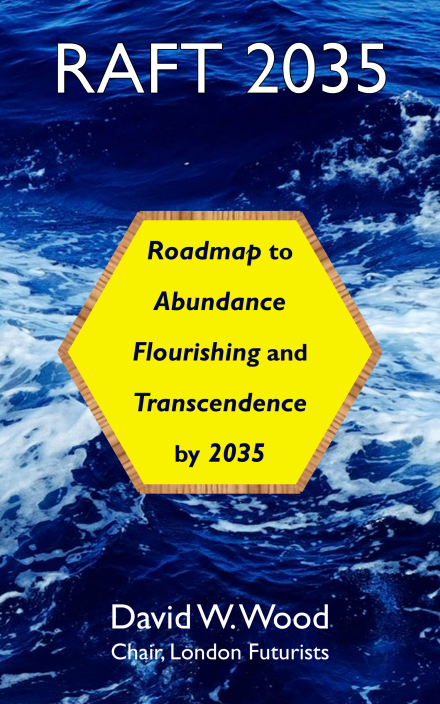Available for purchase and download (from 30th June 2015)
- Envisaging Politics 2.0: How AIs, cyborgs, and transhumanism can enhance democracy and improve society
- Amazon International, Amazon UK, DE, FR, ES, IT, NL, JP, BR, CA, MX, AU, IN…
 Table of contents
Table of contents
- Introduction: Why Politics 2.0 – by David W Wood
- Zoltan Istvan’s “Teleological Egocentric Functionalism”: a libertarian philosophical basis for “Transhumanist” politics – by Roland Benedikter, Katja Siepmann, and Annabella McIntosh
- Four political futures: which will you choose? – by David W Wood
- How do governments add value to society? – by Bruce Lloyd
- The benefits of digital democracy – by Walter L.S. Burrough and Kay Firth-Butterfield
- Cyborgization: a possible solution to errors in human decision making – by Dana Edwards and Alexander J Karran
- Of mind and money: post-scarcity economics and human nature – by Stuart Mason Dambrot
- Voluntary basic incomes in a reputation economy – by Michael Hrenka
- Specifications: an engineer’s approach to upgrading politics – by René Milan
- Extended longevity: an argument for increased social commitment – by MH Wake
- Longevity, artificial intelligence and existential risks: opportunities and dangers – by Didier Coeurnelle
- Prolegomena to any future transhumanist politics – by Steve Fuller
About this book
The single most important task of the next ten years is to find better ways of cooperating. In an age of unprecedented crowds – both online and offline – the global human community urgently needs social mechanisms that will encourage the wisdom of crowds rather than the folly of crowds.
Our existing methods of mutual coordination seem to produce more strife than harmony these days. We’re struggling to cope with ever larger tensions and disruptions on the shrinking world stage. The nation state, the multinational business firm, the free market, the non-governmental organisation, the various international bodies of global coordination set up after the Second World War – all find themselves deeply challenged by the myriad fast-evolving overlapping waves of stress of the early twenty-first century.
We’re facing tragedies of the commons writ larger than ever before. The actions that make good sense to smaller groups often add up, perversely, to disastrous outcomes for the larger community. But attempts to coordinate actions to avoid such tragedies are falling foul of numerous deep-seated conflicts of interest.
Politics 1.0 has taken us a long way. But the multidimensional, intersecting nature of present-day issues and opportunities requires a new calibre of politics. Anticpating that new calibre of politics is the central purpose of the think tank Transpolitica which has published this volume.
The essays in this book provide visions of what Politics 2.0 might look like. They express the thoughts, hopes, and fears from a diverse mix of futurists, political thinkers, academics, and think-tank members. They explore various ways in which new technology might enable improved politics (analogous to the way in which technology enabled the emergence of a collaborative “Web 2.0” with community intelligence, superseding the top-down “Web 1.0”):
- Relevant expert knowledge being quickly brought to vexed questions of subsidies, regulations, standards, and so on – rather than politicians being out of their depths
- Automated fact-checking taking place in real-time, rather than mistakes and errant claims being allowed to influence political discussion for too long
- Humans improving their own cognitive skills, as part of a process we can call cyborgization
- External artificial intelligence augmenting the decision-making capabilities of humans
- The insights of the transhumanist movement, which boldly upholds the possibility of a profound social transformation alongside human physical and mental enhancements.
Cover design
The book cover is based on a design by Alberto Rizzoli.

